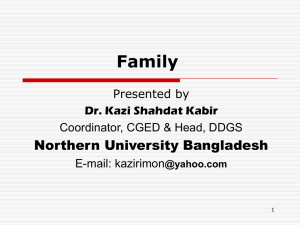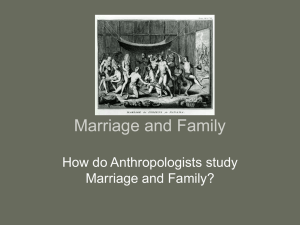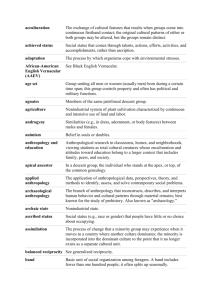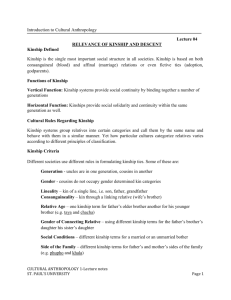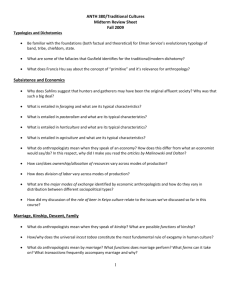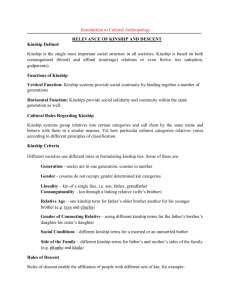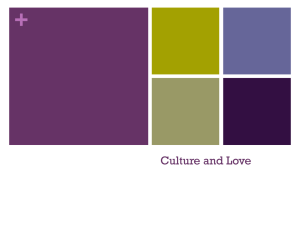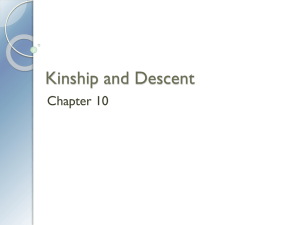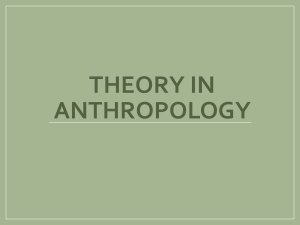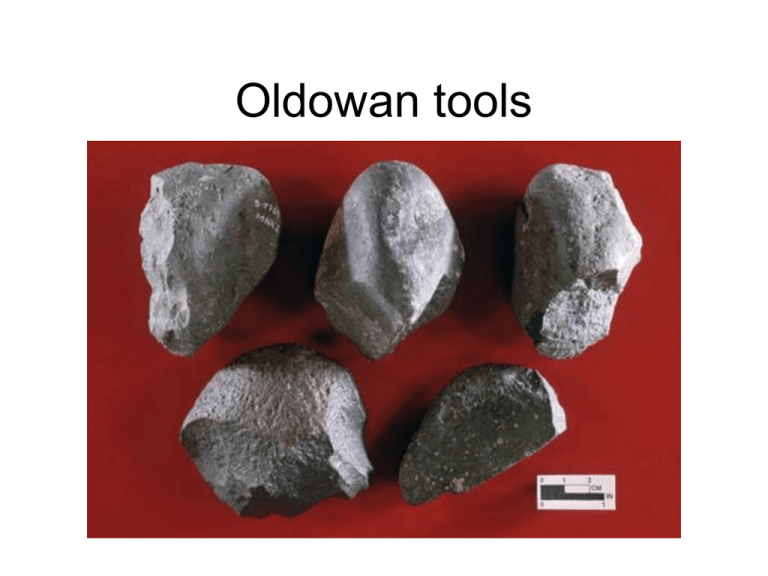
Oldowan tools
Oldowan tools
•Possible Australopithecine use
•Certain Homo use
•2.6-1.7mya
•1.7mya: Acheulean took over
Major Concepts in
Sociocultural Anthropology
•
•
•
•
•
•
Maps
Concept of ethnocentrism
Concept of social constructionism
Concept of cultural relativism
“right and wrong”?
Other major aspects of sociocultural anthropology
Maps
All humans study, make, and use maps (a human universal)
Maps
• A map is a visual representation of an area—a
symbolic depiction highlighting relationships between
elements of that space such as objects, regions,
ethnic groups, nations, etc.
• Cartography, or map-making is the study and
practice of crafting representations of the Earth upon
a flat surface.
• Many maps are 2-dimensional representations of 3dimensional space.
• Several factors can cause maps to be very different
from one another such as orientation, scaling, and
ethnocentrism?…
Maps:
Orientation
“North” and
“South”
poles
inverted
Maps: Orientation
Maps: Scaling (Mercator)
Greenland
Antarctica is really smaller than Asia, Africa, N. and S. Americas
Maps: Robinson Projection is
a Compromise
Ethnocentrism
• Looking at the world’s other cultures
from the perspective of one’s own
culture
• Often associated with a preference for
one’s own culture’s practices
Social Constructivism
• The idea that what one
believes/thinks/knows is determined by
one’s our society
• Knowledge is learned socially from
other members of our cultures; (it is
“constructed socially”)
Cultural Relativism
• The principle that an one’s beliefs and activities
should be understood in terms of one’s own culture
• In anthropology, one must suspend judgment on
other peoples’ practices in order to understand them
in their own cultural terms
– Not always possible
– Not always easy…
Cultural Relativism
•
•
•
•
•
•
•
•
•
•
•
•
•
•
Eating bugs?
Eating hot dogs?
Eating dogs?
Gender roles?
Rodeos?
Birth control?
Bullfighting?
Burkas?
Infanticide?
Abortion?
Nazis?
Female genital mutilation?
Drug use in subcultures in the US?
Polygynous marriage in Chechnya? Utah? Yanomamo?
Who is right?
• That is irrelevant in anthropology
• Practicing cultural relativism is NOT about
trying to say that a particular practice in a
culture is RIGHT or WRONG
• What we’re trying to do in anthropology
UNDERSTAND HUMANS
• (hopefully…)
Other major aspects of
sociocultural anthropology
Sociocultural Anthropology Definitions
Society + Culture
• Haviland et al. 2007—a best-selling, introductory
sociocultural anthropology text
• Society: an organized group or groups of
interdependent people who generally share a
common territory, language, and culture and who act
together for collective survival and well-being
• Culture: A society’s shared and socially-transmitted
ideas, values, and perceptions, which are used to
make sense of experience and generate behavior
and that are reflected in that behavior
Other Ideas on Society and Culture…
Behavioral Ecology on
Society & Culture
– Behavioral Ecology: the study of animal behavior
that emphasizes evolutionary and ecological
principles
– Animals form groups; are these “societies”?
– Is “culture” limited to humans?
Animal aggregations,
societies, or something else?
•
•
“Herd” implies that the group tends to act
together (for example, all moving in the
same direction at a given time), but that
this does not occur as a result of planning
or coordination. Rather, each individual is
choosing behavior that corresponds to
that of the majority of other members,
possibly through imitation or possibly
because all are responding to the same
external circumstances. A herd can be
contrasted with a coordinated group
where individuals have distinct roles.
Is a society more than a herd?
Many primates:
Clear societies according to
behavioral ecologists
• Society: exists in
many species, not
just people; also,
unlike a mere
association of
individuals in that it
involves relationships
and interactions
within and between a
society, at the level of
the individual, group,
subgroup, etc.
Behavioral Ecology on Culture
•
•
“Culture” is not limited to humans
Boesch and Tomasello: culture is the nongenetic
transfer of information among members of social
groups
• Stuff one learns from others
• Example: potato washing in Japanese macaques
(“snow monkeys”), though questioned because
perhaps it is just trial-and error-learning
• Example: foraging culture in chimpanzees…video
• E.g., numerous primate
– Research by C. Boesch and M. Tomasello of
Leipzig’s Max Planck Institution for Evolutionary
Anthropology: experimental and field data
showing that chimps have culture
•
Video:
http://www.youtube.com/watch?v=NivAusARwd8
Chimpanzee Culture (Foraging only)
“+” means behavior was
observed
“-” means it was not observed
“(-)” means the materials
relevant to the behavior were
absent and thus unobservable
Culture Definitions
by Sociocultural Anthropologists
•
•
•
•
Sir Edward Burnett Tylor offered the first
definition in 1871: “[culture is] that complex
whole which includes knowledge, belief, art,
law, morals, custom and any other capabilities
and habits acquired by man as a member of
society”
Kroeber and Kluckhorn collected over 100
definitions that had been generated between
Tylor’s time and the 1950s
More recent definitions separate actual behavior
from the shared ideals, values, and beliefs that
people use to interpret, experience and
generate behavior
Culture as defined by many biological
anthropologists: stuff you learn from others
Anthropology’s History
(in a few slides)
• Anthropology is a product of Western civilization
• Started in Europe (specifically, social anthropology at
the London School of Economics)
• Also greatly relevant to issues of colonialism:
Europeans happened to have power associated with
various technologies, and they used them to colonize
lands occupied by indigenous peoples who often
lacked these technologies due to arbitrary historical
factors
Man’s ‘Natural State in Nature’
Rousseau and Hobbes commented on man’s ‘natural’ state in nature, i.e., outside of
‘civilization; Hobbes said we’re naturally bad and civilization makes us good;
Rousseau, the opposite
Colonialism
• Colonialism is the extension of a nation's sovereignty over
territory beyond its borders by the establishment of either settler
or exploitation colonies in which indigenous populations are
directly ruled, displaced, or exterminated.
• Colonizing nations generally dominate the resources, labor, and
markets of the colonial territory, and may also impose sociocultural, religious, and linguistic structures on the indigenous
population.
• The term colonialism may also be used to refer to an ideology or
a set of beliefs used to legitimize or promote this system.
Colonialism was often based on the ethnocentric belief that the
morals and values of the colonizer were superior to those of the
colonized; some observers link such beliefs to racism and
pseudo-scientific theories dating from the 18th to the 19th
centuries.
Social vs. Cultural Anthro
History
• British social anthropologists were interested in
documenting aspects of different cultures using
somewhat standardized measures: kinship systems,
social structure, matrilocality vs. patrilocality, etc.
• American cultural anthropologists (starting with Franz
Boas who studied indigenous NW Americans), was
more interested in understanding the beliefs and
particular ways of life of other cultures—and less
interested in documenting their properties in a
Western vocabulary
• Fuse these traditions together: sociocultural
anthropology
Terms
• Ethnography: the systematic description of a
culture based on firsthand observation
• Ethnographer: an anthropologist who does
this
• Not all anthropologists are ethnographers
• Indigenous: the people who lived in a region
before a region was colonized (by, usually)
Europeans
Participant Observation
• Definition: In ethnography, the technique
of learning a people’s culture through
direct participation in their everyday life
• Examples
– Hewletts: Aka of Central Africa
– Chagnon: Yanomamö of South America
– WSU’s Wilkinson-Weber: Bollywood
– Hess: Delta Nus of Southern California
Subculture
• A culture within a culture
• A distinctive set of standards and behavior
patterns by which a group within a larger society
operate
• Many in the US are studied by anthropologists
(e.g., hip-hop culture; culture of the elite; KoreanAmerican culture in Los Angeles)
• Note culture and subculture are not always
perfectly cleanly-divided, and one can be a
member of multiple subcultures
• Other examples of US subcultures?
Ways of Categorizing
Cultures…
The nature of groups, their
members, internal relationships,
and other factors
Subsistence: getting food
• Foraging (hunting and gathering): usually wild foods, associated with
nomadism; includes net-hunting, bow-and-arrow hunting, gathering
insects and plant foods, etc.)
• Horticulture: smaller-scale farming, often slash-and-burn; plants are
domesticated; does not preclude foraging as well
• Agriculture: large-scale farming of domesticated plants; often includes
technicological advances like irrigation
• Pastoralism: herding domesticated animals (e.g., cattle), and
interacting with the animals as food, as money, etc.
• Industrialism: large scale, technically-advanced production of
processed foods that are bought and sold in a market
• Note: from foraging to industrialism you get increased sedentism,
increased surplus, and thus increasing population density
Kinship
• A system of social ties deriving from the
recognition of genealogical relations
• Universally recognized
• Universally accorded social importance
Types of Kin
• Consanguineals: relatives by birth/genetics (“blood”
relatives)
• Affinals: relatives by marriage (one’s spouse and inlaws)
• Conspecific: members of the same species
• Fictive kin: a person who is not kin that gives a kin
title to, and often treats them as they do actual kin
with that title
• Lineal relatives: ancestors and descendents (my
mom’s mom; my daughter)
• Collaterals: relatives descended from a common
ancestor but from a different line (I.e., related through
siblingship; cousins)
Kinship Diagrams
•
•
•
•
•
•
Triangle male
Circle female
= married
— sibling
I descent
Ego self
Descent Terms
• Unilineal
– Matrilineal: descent is traced through the
mother’s line
– Patrilineal:descent through the father’s line
• Ambilineal: descent through either line
• Bilateral: descent traced through both
lines
Descent Groups
• Recognize descent from a real or mythical ancestor
• Assign people to social categories and roles on the basis of inherited
status
• Determine parenthood
• Identify ancestry
• Assign status
• Regulate relations with other groups
• Obligations and roles keep the group together
• Sometimes involve totems: the belief that people are related to
particular animals, plants, or natural objects by virtue of descent from
common ancestral spirits
• Endure beyond individual members
• Confer political and religious power
• Share resources (property, organized labor, etc.)
Kinship Terminology
and Kinship Groups
•
•
•
•
•
•
•
Ways of categorizing kin vary across cultures. In the US, we call our
fathers “father” and our father’s brother “uncle”--not so everywhere in
the world
In the Yanomamo, one refers to her father and his brother both as
“father”--”fictive kinship” (at least from OUR perspective)
Unlike English, many languages distinguish between a mother’s sister
and a father’s sister; we lump them as “aunt”
These names impact the quality of relationships individuals have within
a group
Anthropologists have discovered that there are 8 ways in which
cultures categorize relatives. The names of each of the 8 systems are
those of the cultures in which a pattern of categorization was first or
best documented by an anthropologist:
Eskimo, Hawaiian, Iroquois, Crow, Omaha, Sudanese, Kariera, and
Aranda
We will only look at the first 3, as they are the most common
Eskimo System
• What European and European-derived cultures use,
though rare among all the world’s other cultures
• Many foragers use it (including Inuit and other
Eskimos, hence the name)
• Emphasizes the nuclear family
• Also called lineal system
• IDs mother, father, brother, sister specifically
• Lumps all other relatives into aunt, uncle, and cousin;
note this does not emphasize which side of the family
an “aunt” is on--mom’s or dad’s
Hawaiian System
• In Hawaii and many other South Pacific societies
• Least complex system with fewest kinship terms
• All relatives of the same generation and sex are
referred to by the same term
• Father and father’s brother use the same term
• First cousins are equated with brothers and sisters
(rules them out under an incest taboo)
• Reflects an absence of unilineal descent
Iroquois System
• Father and his brother are referred to by a single
term
• Mother and her sister by a single term
• But father’s sister and mother’s brother are given
separate names
• Found in societies with unilineal descent groups
• Parallel cousins are classified with brothers and
sisters
• Cross cousins are classified separately, but not
equated with relatives of another generation
Cross vs. Parallel cousin
• Parallel cousin: child of a father’s brother or a
mother’s sister; occurs more in societies that are very
hierarchical and have large amounts of property to
inherit (inheritance through one line)
• Cross cousin: child of a father’s sister or a mother’s
brother; more common in foragers
• Cousins of particular categories are one’s optimal
mate in several cultures
• In Yanomamo culture, cross-cousin marriages are
preferred as marriage partners, parallel are avoided
Kinship Centered Political
Organization
Structures of Descent
• Lineages (patri/matri/ambi/bilateral): common ancestry
• Clan: several lineages common ancestor, usually large
groups that are associated with mythical ancestors
• Phratry: descent group composed of a number of
supposedly related clans
• Moieties: means half, when an entire society is divided into
2 and only 2 descent groups
• Many societies have 2 or more types of descent groups in
various combinations (e.g., some have lineages & clans,
others may have clans & phratries but no lineages)
Family Groupings
• Nuclear family = mother, father, and
their child(ren) and stepchild(ren)
• Extended family = multiple nuclear
families and/or more than 2
generations; clustered together
domestically on a day to day basis
Mating/Marriage
• Mating: lots of meanings (sex, temporary bonds, long-term
romantic exclusivity, humans do it, plants do it, etc.)
• Marriage (A): A transaction and resulting contract in which a
woman and a man are recognized by society as having a
continuing claim to the right of sexual access to one another,
and in which the woman involved is eligible to have children
• Marriage (B): a culturally-sanctioned union between two or more
people that establishes certain rights and obligations between
the people, between them and their children, and between them
and their in-laws. Such marriage rights and obligations most
often include, but are not limited to, sex, labor, property, child
rearing, exchange, and status.
(A) Haviland 1996
(B) Haviland 2008
Exogamy & Endogamy
• Endogamy – marriage (or mating) within a particular group
or category to which one belongs
• Exogamy – marriage (or mating) outside one’s group
– Remember this when we talk about nonhuman primates in the
biological anthropology portion of this class
• *Can be exogamous at one level of grouping and
endogamous at others--e.g., you marry someone from a
different city, but not a different state
• Male exogamy/female exogamy in humans and other
animals: at least one sex usually leaves--why?
• Incest taboo: the prohibition of sexual relations between
specific individuals (usually parent-child and siblings, at a
minimum)
• Inbreeding avoidance across species (us too)
Marriage Systems
• Monogamy: two people only
• Polygamy: more than two people
– Polygyny: 1 man, multiple women (quite common)
– Polyandry: 1 woman, multiple men (very rare)
• Serial Monogamy: a person is partnered with a
succession of individual partners over time (e.g.,
divorce and remarriage)
• Promiscuity: multiple partners of any sex
configuration
• Most Americans use “polygamy” when they are
referring to “polygyny”
Some marriage practices
• Levirate: a custom by which widow
marries the brother of her dead
husband
• Sororate: a custom by which a widower
marries his dead wife’s sister
Marriage Economics
• Dowry: when the wife’s family gives her her
inheritance at the time of her marriage (women
sometimes ‘compete’ for desirable, e.g., wealthy,
husbands with this)
• Brideprice: when the groom and his family give goods
to the bride’s family in exchange for the right to marry
her; often in female-exogamous societies (her family
loses the economic contribution she had been
making)
• Brideservice: when, prior to marriage, the groom lives
with and works for the bride’s family for a given
period of time (years)
Arranged Marriages
• In many cultures, the families of the betrothed choose
one’s spouse.
• Even in the US, families “steer” their children to the
“right” family or category of person, e.g., restrictive
private schools and carefully-orchestrated social
gatherings.
• Marriages create alliances among families (e.g.,
transfers of rights and property), so families have a
lot at stake
Marriage and Locality
(Residence Patterns)
•
•
•
•
Patrilocal: a married couple lives in the husband’s father’s place of residence;
occurs where men play a dominant role in subsistence, particularly if they own
property that can be accumulated, if they are polygynous, if warfare is common,
and if men weild great social authority compared to women; associated with
bride-price
Matrilocal: a married couple lives in the wife’s mother’s house; occurs where
women are dominant in subsistence (often in horticulture cultures where the
women own the land and the harvest), where political organization is relatively
uncentralized, and where cooperation among women is important
Ambilocal: choose either husband’s father’s or wife’s mothers; occurs where
resources are limited, but where the labor of more than one nuclear family is
required to acquire the scarce resources--the couple goes to whichever
household will bring about the most efficient productivity
Neolocal: reside in a location apart from either the husband’s or the wife’s
relatives; occurs where most economic activity occurs outside the house and
individuals must be able to move to where the jobs are; associated with
industrialism (us)
Example
• USA (on average): neolocal, cousin marriage very
rare, bilateral descent, emphasis on nuclear families,
lots of nonkin grouping by age (school), industrial
subsistence (mostly), sodalities--sometimes one’s
high school class (often they unite with a mascot, for
example), etc.
• The “patris” don’t always go together; for example, a
culture can be matrilineal (trace descent through
matrilines) and patrilocal (live at the residence of the
husband’s father)
Methods
• Participant observation: in ethnography,
the technique of learning a people’s
culture through social participation and
personal observation within the
community being studied, as well as
interviews and discussion with individual
members of a group over an extended
period of time.
Participant Observation
• Exactly what Chagnon does--this is utterly
clear if you read his book!
• Exactly what Barry and Bonnie Hewlett do—
they live with the Aka for long amounts of
time in order to understand their culture
• Me too (though I am not a sociocultural
anthropologist, and I was not initiated as a
Delta Nu)…
College Sororities
(3-year ethnography emphasizing “Rush” and
cooperation/conflict among housemembers)
Yanomamö
•
•
•
•
•
•
•
•
•
•
•
Patrilineal descent
Patrilocal marriage
Cross-cousin marriage
Name taboos
Warfare
Feasts
Peacemaking
Alliances
Child betrothal
Wife capture
Polygyny
Shabono; Flooding
Yanomamö village Cejal in Summer 1998
(note differences from Chagnon’s ethnography; here
they’ve had years of extensive interaction with
missionaries, Venezuelan government, mainstream
economy, etc.)
Hunting
Fishing
Slash and
Burn
Horticulture
Gathering
River trade
Yanomamö
• Cesar Demanawa
Headman
(César Dimanawa)
Preparing for a feast
Infectious disease and
Grooming

